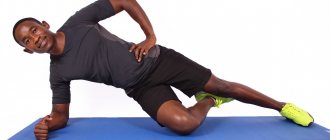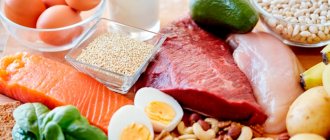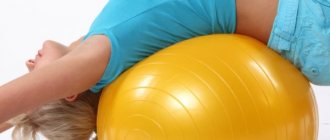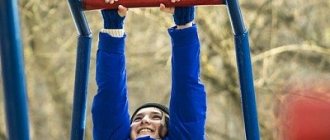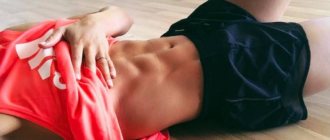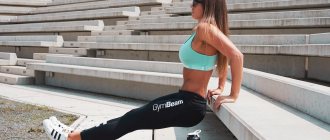Not muscles, but “mountain”? In fact, this is the reality for every bodybuilder. This very reality is called pumping. The bottom line is that in the process of performing special exercises, certain muscles are visually pumped. They acquire super-volume, which lasts for 20-30 minutes (sometimes up to 1 hour). Bodybuilders most often resort to pumping before going out in public. Pumping does not provide enormous strength and endurance, but it looks great. Pumping has no gender restrictions - it is used simultaneously by representatives of the strong and weak half of humanity.
The best training programs for pumping muscles
There are several programs for pumping different muscle groups and areas of the body (types of pumping training). They were compiled by experienced trainers using personal trial and error. The complex must be carried out strictly according to plan in order to achieve visible and desired results. The effect is visible after the first lesson. Over time, the pumping effect will last longer. The muscles will remember this feeling and try to maintain it.
Muscle pain and other disadvantages of pumping
The increase in muscle volume achieved during pumping does not last long. Visual increase in muscles is a short-term pumping effect. After the blood drains, the muscles contract again. Pumping workouts improve muscle endurance and temporarily increase muscle size, but they do not promote muscle growth. Another type of training is more suitable for gaining mass: with a small number of repetitions and high working weight. Too intense pumping workouts can even burn muscle tissue.
Another disadvantage of pumping is severe muscle pain that occurs during or after training. It is associated with microtrauma of muscle fibers and with the accumulation of breakdown products, mainly lactic acid. This acid is formed as a result of the breakdown of glucose. In addition to lactic acid, the oxidation of glucose produces hydrogen ions, which act as a local vasodilator. The second factor in vasodilation in muscles is adenosine, a breakdown product of the energy-storing molecule ATP.
That is, actively working skeletal muscle, as it were, pumps itself with blood. It consumes energy, which is supplied by ATP molecules. The breakdown of ATP produces adenosine, one of the vasodilating factors. In addition, in the working muscle, glucose is oxidized to lactic acid, which produces hydrogen ions - another factor in vasodilation. In skeletal muscles, under load, blood flow can increase 10-20 times. But at the same time, metabolic products (lactic acid, hydrogen ions) are intensively formed, which cause burning, nagging pain and a feeling of fatigue.
Pumping the pectoral muscles
Includes:
- bench press in a lying position;
- butterfly;
- bent over dumbbell flyes;
- Bent-over dumbbell press;
- pullover,
- information in the crossover through the lower blocks.
You need to perform the exercises using trisets, for example – bench press, butterfly and pullover, the second option – bent over dumbbell press, bent over dumbbell flyes, crossover exercises through lower blocks. This means alternating exercises, performing them one after another without rest breaks. This rather heavy type of pumping, such as negatives, is also very suitable for the chest. The bottom line is that you first need to isolate the muscle, then pump it well. An example would be to perform the butterfly exercise - since it is isolating, and then do the base - the bench press. You need to start with 3 sets of 10-15 repetitions. Over time, it is imperative to increase the number of approaches and repetitions. After a month there should be at least 6 approaches for the pumping to be noticeable. Exercises can be performed using various pumping techniques. The main thing is to gradually increase the number of repetitions without fail.
Types of Pumping training
Pumping muscles with blood is carried out in several ways. Complexes can be alternated and combined. But not a single pumping workout is possible without strength loads.
Standard workouts
This complex includes basic exercises with dumbbells or a barbell. A large number of repetitions are performed with a minimum of intervals. You can also use the simplest and most well-known exercise for pumping the pectoral muscles - push-ups.
Drop set
This method is also called “Dropping” and consists of performing strength work with a minimum break between approaches and gradually reducing the weight. An example of such pumping training could be the following sets:
Standing dumbbell bicep curls:
- 2 sets of 10 times with a 5-kilogram apparatus in each hand;
- The third approach is 8 times with the same weight, 4 and 5 – 16 times each with 3 kg dumbbells;
- Stretching exercise with final contraction of muscle fibers.
Calf raises on a Smith machine (working weight - 100 kg):
- 4 times 100 kg;
- 3 times 80 kg and 60 kg.
You will find all the necessary information about drop sets in this article.
Super set
It is the most effective pumping method, which combines two different exercises for one muscle group or muscle groups located next to each other. It is necessary to perform elements without skipping repetitions, respites or breaks, otherwise the effectiveness of pumping training will decrease. The athlete can choose the exercises and number of repetitions.
Best pairings for a super set:
- Biceps + triceps - a combination of dumbbell extension from behind the head in a sitting (or lying) position with a classic biceps curl;
- Biceps femoris + quadriceps femoris - performing seated leg extensions and leg presses with working weight.
We wrote in detail about supersets in this article.
Peak contraction
The exercises are performed as usual, but during the approach it is necessary to hold at the very peak for a couple of seconds. For example, when bending your arms with dumbbells, the delay occurs at the highest point.
Partial repetition
This method is recommended to be performed before completing a workout, when you feel tired. Pumping exercises with partial repetitions are very effective, although they are not done at full strength, but at 1/2-1/4 amplitude (shortened amplitude). This may cause severe tingling or burning in the muscles, but this is normal. It is also necessary to observe the number of repetitions from 8 to 10 or more.
Pre-fatigue
This is a very heavy type of pump, but quite effective, with a long-lasting effect. The bottom line is that you initially need to isolate the muscle, and then load it almost to failure. The training program may include the following exercises:
- For triceps: a combination of bench press with a narrow grip and extension of the arms in a block machine;
- On the legs: seated leg extension combined with classic squats.
It is better for novice athletes not to use this type due to its increased risk of injury.
Burning
First, the exercises are performed as usual. But as soon as the athlete feels tired, he begins to sharply increase his speed until his power reserves are fully exhausted.
Back pumping
Good for back pumping:
- classic deadlift, sumo;
- Bent-over barbell row;
- upper block thrust;
- traction to the waist while sitting;
- Pull-ups with a wide grip behind the head.
They need to be performed without breaks using the method of supersets and trisets. Option one – classic deadlift, bent-over barbell row, lat pulldown. Option two – pull-ups with a wide grip behind the head, rows to the waist while sitting. Other pumping methods are also applicable here, burning, for example, or even pre-fatigue. The back muscles are weak to pumping, so they require special attention from the bodybuilder. Stepped approaches can be used.
Pumping for the buttocks
Ideal for this type of pumping:
- squats;
- Dead deadlift on straight legs;
- leg abduction;
- lunges;
- hyperextension;
- gluteal bridge.
All exercises must be done in sets, then they will bring the most beneficial effect. For example, deadlift + glute bridge, barbell squats + leg abductions, lunges + hyperextension.
Arm pumping (biceps, triceps)
For this type of pumping the following would be appropriate:
- Bending arms with handles using upper crossover blocks;
- Hammer exercise;
- Concentrated arm curl with a dumbbell while sitting;
- Biceps exercises on the Scott bench;
- French bench press;
- Close grip bench press;
- Extension from behind the head;
- Blocked triceps extensions.
Here you can use different pumping methods (super sets, drop sets, partial repetitions, pre-fatigue, peak contraction, burn). This area of the body can be easily enlarged and pumped up. It’s important not to overdo it, but underdoing is also bad; the pumping simply won’t be visible. In moderation - this is the main principle of pumping this zone. You need to start with 3 approaches and 10-15 repetitions. Increase over time is necessary.
How to do pumping correctly?
There are several ways to pump blood into muscles, but they all have one very important point in common - the exercises are performed with light weight and a high number of repetitions. The rest time between sets is minimal (from 30 seconds to 1 minute). Let's see how to do pumping correctly and what training techniques can be used to achieve it.
Drop sets
Initially, we perform the exercise with the maximum load for your level of training, but with each subsequent approach we reduce the weight by 25 percent. Accordingly, the number of repetitions in each set will increase. Ideally, you need to do the exercise until the muscles completely fail. The same technique can be performed in the opposite way, that is, with increasing weight and decreasing the number of repetitions with each new set.
Supersets
We alternately work on the antagonist muscles (flexors-extensors). For example, we perform one approach for biceps, and the second for triceps. Rest breaks are minimal or non-existent.
Negative repetitions
When performing the exercise, we pay special attention to reverse movements. Concentrate on the working muscle and lower the barbell slowly.
Partial reps
When finishing a set, when we cannot fully perform the main exercise, we “finish off” the muscle with repetitions of half or a quarter of the amplitude. Thus, we squeeze the maximum out of the approach.
Pre-fatigue
We warm up the muscle group being pumped with an isolating exercise and bring it to complete fatigue with the “base”. For example, when pumping up the quadriceps, we perform 1-2 sets of leg extensions while sitting, and then move on to the main exercise - the leg press in a block machine.
Peak contraction
At the top point of the movement, you need to linger for a few seconds. This will provide an additional flow of blood to the desired muscle.
Cheating
It is also a good means to achieve our goal. After the exercise becomes impossible to perform technically, we begin to help ourselves with other parts of the body (we make energetic jerking movements to remove some of the load from the tired muscle). However, remember that as your speed increases, your metabolism will also increase, which can lead to unnecessary muscle burning.
Shoulder pump
Ideal exercises would be:
- Military press with a barbell or dumbbells;
- barbell pull to the chin;
- abduction of arms with dumbbells to the side;
- Arnold press;
- raising your arms with dumbbells in front of you.
You need to start with the notorious 3 approaches and 10 repetitions, performing the exercises in supersets. You can take short breaks between approaches. Shoulder pumping is achieved quickly with the correct load on this area. The effect lasts about 30 minutes.
Productive pumping[edit | edit code]
Today there is no clear opinion about the benefits of pumping for bodybuilding. Accurate data backed by research is lacking. However, there are facts in favor and against pumping in bodybuilding.
As a rule, pumping is achieved through a large number of repetitions, the number of which exceeds 15. Currently, sports medicine is firmly convinced that high-repetition sets are ineffective if the goal is to increase muscle mass. The fact is that this approach involves the use of light weights, which stimulate muscles to grow much weaker. And this has been proven by dozens of experiments.
Training with a large number of repetitions, as a rule, has one pronounced effect - muscle pain, which occurs as a result of the accumulation of lactic acid in the muscles, acidification of the intercellular environment and the formation of other metabolic products. Lactic acid is the result of anaerobic glycolysis in muscles, in other words - waste. It is believed that the breakdown products of nutrients, or waste products (including lactic acid), have a growth-stimulating effect on muscles and cause increased secretion of testosterone.
In Gunther's words, obviously, lies an explanation of the biochemical meaning of the saying “Without pain there is no progress in bodybuilding”; Strength training aimed at gaining muscle mass also includes lactic acid. However, keep in mind that muscle pain can be pathological.
Read the main article:
Muscle pain after exercise
In addition, increased blood supply is in favor of pumping. Blood supplies oxygen and various nutrients to the muscle, muscle tissue becomes more resistant to stress and recovers faster. Increased blood flow eliminates excess lactic acid from the muscle and restores the acidity level of the intercellular space, and this also promotes recovery.
Pumping exercises are especially recommended for those who have started bodybuilding relatively recently.
Pumping exercisesedit | edit code
- Drop sets
- Supersets
- Pre-fatigue
- Burns
- Partials
- Negatives
- Peak contraction
- Forced reps
Pumping exercises for the legs are especially useful. It is common knowledge that leg muscles respond particularly well to high repetitions. This is where pumping exercises come in handy. Best option for quads and calves
muscles: exercises with preliminary fatigue, burns and forced reps.
Biceps pump:
- curls with dumbbells while sitting or with a barbell while standing
- curling arms with dumbbells while sitting on an incline bench
- curls with a barbell on a Scott bench from a position of 90°
Triceps pump:
- arm extension with EZ barbell with reverse grip
- arm extensions with EZ-bar with a regular grip
- arm extensions with hummer dumbbells
Pumping on the press
Abdominal pumping consists of two basic exercises. This is a hanging leg raise and twisting. Leg lifts must be performed on a special horizontal bar. You can lean on the handrails with your elbows or hang by grabbing the bar. This is not the main point. The legs should be raised at a right angle or tucked towards the stomach at the knees. This exercise works great for muscles. Immediately after it, you need to lie on the floor and do about 30 crunches. Over time, the number of repetitions must be increased, otherwise there will be no effect.
Leg pumping
Here, experienced athletes recommend performing squats and leg bending and extension. Ideally, both pumping exercises will be performed in superset mode, then the benefits will be obvious quickly. You don’t need to squat deeply, not all the way, it’s enough to sit down on a chair. At first, you can perform the exercise next to a chair and bench, as if sitting down on them. You need to start with 10 repetitions and 3 approaches, after a month the amount should be increased by 2-3 times.
Pumping in bodybuilding
Strength training involves “overloading” the muscles. Which may be the cause of delayed onset muscle pain . Naturally, it interferes with carrying out a full training session if it does not take place before the next training session. Therefore, it is recommended to avoid it! But it is well known that greater load gives greater results. True, only if the body manages to “digest” it. And it is precisely to “digest” the load that pumping training can help. Which are best done between training sessions. Not to mention, they help improve neuromuscular communication. Because the more often you use something, the better you get at it.
You can use pumping in bodybuilding and as an independent training program. What should you do after going through any power circuit. Because pumping helps you recover after it. Moreover, it is during this recovery period that the main synthesis of muscle proteins will occur. Which the athlete had previously actively destroyed with strength training for 2–6 repetitions to “failure.” And precisely because this is rehabilitation training, which should also ensure restoration of the musculoskeletal system, it is recommended to use simulators and isolation exercises for pumping. Just to avoid overloading your joints!
Muscle hypertrophy system
Bandages for pumping
Pumping training for women
Programs for the fair sex do not differ much from those combinations that are offered to the stronger sex. The only relaxation is the number of approaches and repetitions. Ladies can start with the same 3 sets of 8-10 reps. The number needs to be increased. After a month, there may be 5 approaches and 15 repetitions. It all depends on what effect the athletic lady expects from pumping.

